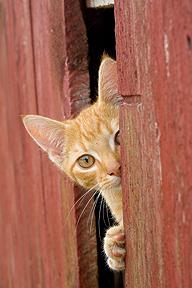Barn and Working Cat Program

Rochester Animal Services sometimes has cats that may not be suitable for adoption as house pets. Cats in the Barn and Working Cat Program come in as strays and fall into three categories:
- Cats with litter box habits that make them unsuitable as house pets;
- Cats that have not adjusted well to the shelter environment and whose behaviors are more acceptable in a barn or other non-traditional home;
- Cats that are fearful of people and prefer the company of other cats or other animals.
We do not release cats as barn cats if they are suitable as house pets, only cats without other options. This is the last chance for these cats; they have nowhere else to go - and for some, time is limited.
The barn and working cat program reaches out to those with an active barn, horse stable, warehouse, plant nursery, or other suitable location with safe outbuildings. Having a barn cat or working cats will help control the rodent population. The cats will help the property owner while the property owner provides the cats with a safe place to live. There is no risk of unwanted litters because these cats are already spayed or neutered.
What Animal Services provides
All cats available for adoption to barns or other non-traditional facilities are spayed or neutered and vaccinated prior to leaving the shelter. When a barn cat(s) is adopted, Animal Services staff will share information with you on how to acclimate the cat(s) to the new environment and make them feel at home.
There is no adoption fee, but donations are welcome to help Animal Services cover some of their medical costs. Since many of these cats thrive in the company of other cats, Animal Services encourages clients to adopt more than one cat at one time.
What you'll need
Those who adopt the barn cats agree to give them:
- Shelter in barns, stables, or other buildings
- Daily food and water - cats cannot live on mousing alone
- Long-term veterinary care, as needed (they're neutered and vaccinated at adoption)
- A secure place to keep them for the first 2–3 weeks while they acclimate to the new environment. This can be a tack room or any secure indoor enclosure from which the cats cannot escape
- The shelter may lend you an introduction cage if no secure area is available






